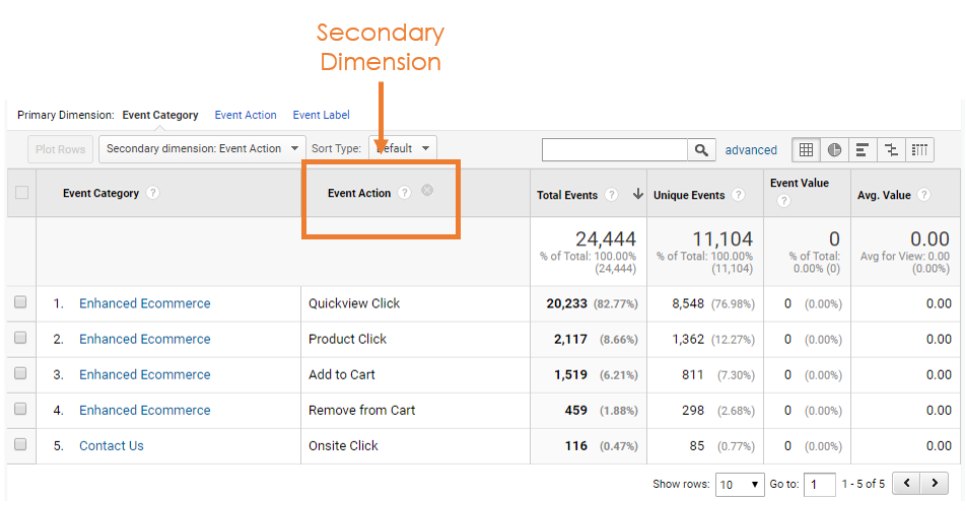Google Analytics Mastery: Unveiling the Possible of Secondary Dimension
Google Analytics Mastery: Unveiling the Possible of Secondary Dimension
Blog Article
Opening the Power of Second Measurement Analytics for Boosted Information Insights and Decision-Making
In the world of data analytics, key dimensions frequently take the spotlight, however real depth of insights exists within the world of additional measurements. These additional data points supply a nuanced perspective that can brighten patterns and connections not readily obvious in the beginning glance. By harnessing the power of additional dimension analytics, companies can introduce hidden fads, discover relationships, and remove more significant final thoughts from their data. The potential for boosted decision-making through the usage of these second dimensions is vast, promising a much deeper understanding of complex information collections and leading the way for more enlightened critical choices.
Value of Additional Dimensions
Discovering the significance of additional dimensions in analytics unveils the hidden layers of data insights essential for informed decision-making in different domain names. Second measurements provide a much deeper understanding of main data by providing extra context and viewpoints. By integrating secondary measurements right into analytics, organizations can extract more nuanced and comprehensive understandings from their datasets.
One secret value of additional measurements is their capacity to sector and categorize main information, permitting a much more detailed analysis of particular parts within a dataset. When looking at the information as a whole, this division makes it possible for services to determine patterns, fads, and outliers that might not be apparent. Additional dimensions help in revealing connections and dependencies between different variables, leading to more precise projecting and predictive modeling - secondary dimension.
Moreover, second measurements play a vital role in improving information visualization and reporting. By including additional dimensions to visualizations, such as charts or graphs, analysts can produce a lot more informative and helpful representations of data, facilitating better interaction of findings to stakeholders. In general, the integration of second dimensions in analytics is crucial in opening the full capacity of information and driving evidence-based decision-making.
Trick Advantages of Making Use Of Secondary Measurements
Using second dimensions in analytics uses companies a critical benefit by augmenting the depth and granularity of data insights. One essential advantage of integrating additional dimensions is the capability to sector and filter information, permitting a more detailed analysis of details aspects within a dataset. This segmentation enables organizations to gain a more nuanced understanding of their target market, performance metrics, and various other crucial data points. By studying data using secondary dimensions such as time, area, gadget kind, or user demographics, companies can discover patterns, fads, and correlations that may otherwise stay covert.
Moreover, the utilization of secondary measurements boosts the context in which primary data is analyzed. By leveraging secondary dimensions in analytics, organizations can harness the full possibility of their data to drive much better decision-making and achieve their service purposes.
Advanced Data Analysis Methods
A deep study advanced information analysis techniques exposes innovative approaches for removing valuable understandings here are the findings from complicated datasets. One such method is machine learning, where formulas are used to recognize patterns within information, forecast end results, and make data-driven choices. This approach allows for the automation of logical design structure, allowing the handling of big quantities of information at a much faster speed than conventional methods.
One more advanced method is predictive analytics, which uses analytical formulas and device learning strategies to forecast future results based on historic information. By evaluating fads and patterns, companies can expect client actions, market fads, and prospective risks, empowering them to make positive decisions.
Furthermore, text mining and belief check here analysis are useful strategies for extracting understandings from disorganized information sources such as social media remarks, consumer evaluations, and study reactions. By examining message data, organizations can understand client viewpoints, identify emerging patterns, and boost their product and services based upon comments.
Enhancing Decision-Making With Second Measurements

Enhancing decision-making through secondary measurements makes it possible for businesses to make even more educated and targeted strategic options. As an example, by segmenting client information based upon second measurements like purchasing background or interaction levels, firms can tailor their advertising and marketing strategies to specific target market sectors, resulting in boosted conversion rates and consumer fulfillment. In addition, second measurements can help recognize correlations and partnerships between various variables, enabling organizations to make data-driven decisions that drive development and productivity.
Applying Additional Measurement Analytics
When incorporating additional measurements in analytics, organizations can unlock deeper understandings that drive tactical decision-making and boost overall efficiency. This involves comprehending the details concerns the organization looks for to respond to and the data factors called for to address them.

In addition, companies should utilize progressed analytics devices and modern technologies to simplify the process of including additional dimensions. These tools can automate data processing, evaluation, and visualization, enabling organizations to concentrate on translating insights instead of hands-on data manipulation.
Verdict
In conclusion, additional dimension analytics play a crucial role in improving data understandings and decision-making procedures. By using sophisticated data analysis strategies and applying secondary dimensions successfully, companies can open the power of their data to drive strategic organization choices.
In the world of data analytics, main measurements frequently take the spotlight, but the true deepness of understandings lies within the realm of second measurements.Using additional measurements in analytics supplies organizations a tactical advantage by augmenting the deepness and granularity of information understandings. By leveraging second measurements in analytics, companies can harness the full potential of their information to drive much better decision-making and achieve their business purposes.
Carrying out data recognition processes site link and regular audits can aid preserve information high quality and dependability.
By utilizing innovative information analysis methods and executing second measurements effectively, companies can unlock the power of their information to drive tactical organization decisions.
Report this page